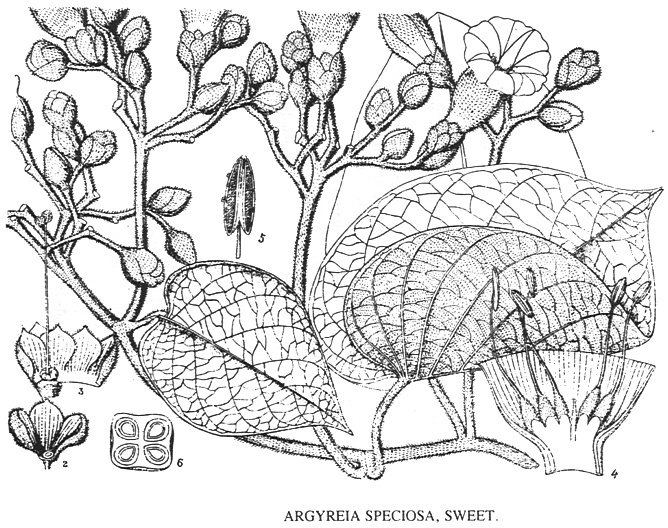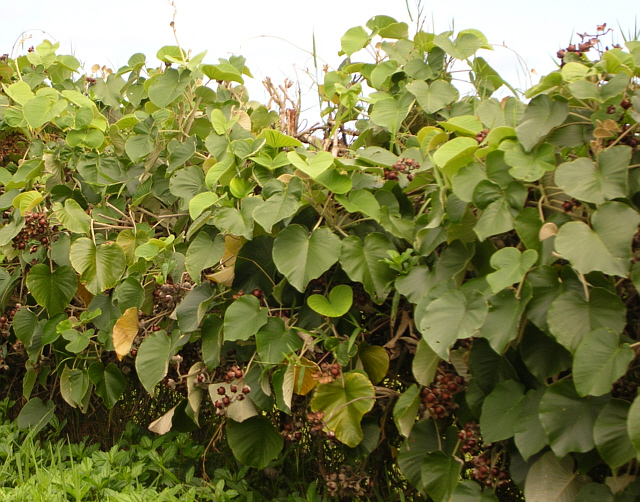

Zitierweise / cite as:
Carakasaṃhitā: Ausgewählte Texte aus der Carakasaṃhitā / übersetzt und erläutert von Alois Payer <1944 - >. -- Anhang A: Pflanzenbeschreibungen. -- Argyreia speciosa Sweet. -- Fassung vom 2007-05-10. -- URL: http://www.payer.de/ayurveda/pflanzen/argyreia_speciosa.htm
Erstmals publiziert: 2007-03-19
Überarbeitungen: 2007-05-10 [Ergänzungen]
Anlass: Lehrveranstaltung SS 2007
©opyright: Dieser Text steht der Allgemeinheit zur Verfügung. Eine Verwertung in Publikationen, die über übliche Zitate hinausgeht, bedarf der ausdrücklichen Genehmigung des Verfassers
Dieser Text ist Teil der Abteilung Sanskrit von Tüpfli's Global Village Library
WARNUNG: dies ist der Versuch einer
Übersetzung und Interpretation eines altindischen Textes. Es ist keine
medizinische Anleitung. Vor dem Gebrauch aller hier genannten Heilmittel wird
darum ausdrücklich gewarnt. Nur ein erfahrener, gut ausgebildeter ayurvedischer
Arzt kann Verschreibungen und Behandlungen machen!
Falls Sie die diakritischen Zeichen nicht dargestellt bekommen, installieren Sie eine Schrift mit Diakritika wie z.B. Tahoma.
Verwendete und zitierte Werke siehe: http://www.payer.de/ayurveda/caraka0001.htm

Abb.: Argyreia speciosa Sweet.
[Bildquelle: Kirtikar-Basu, ©1918]

Abb.: Argyreia nervosa (Burm.) Boj.
[Bildquelle: Wikipedia]
Drury:
"Argyreia Speciosa (Sweet). Do. Elephant Creeper, Eng. Samundar, Hind, and Duk. Shamuddirap-pachchal, Kadal-palai, Tam. Samudra-pala, Chandra-poda, Kokkita, Pala-sarmudra, Tel. Samudra-yogam, Samudra-pala, Mal.
Description.—Twining, tomentose; leaves cordate, acute, glabrous above, thickly nerved beneath, and silky silvery; sepals 5 ; corolla campanulate; peduncles equal in length to the petioles, umbellately capitate; corolla nearly two inches long, deep rose-coloured, hairy in the plicae outside. Fl. July —August—Dec. Prod. ix. 328.—Convolvulus speciosus, Linn. —Lettsomia nervosa, Roxb. Fl. Ind. i. 488.—Rheede, xi. t. 61. — Wight Icon. t. 851,1360. — —Malabar forests. Hedges in the Peninsula
Medical Uses.—The leaves are used by native practitioners in the preparation of emollient poultices, and also in cutaneous complaints, being applied externally to the parts affected. The upper side of the leaves is used by the natives to act as a discutient, the under or white side as a maturant.—(Ainslie. Gibson.) In a case which came under Dr Wight's observation they acted as a powerful vesicant—Wight, 111, ii. 201."
[Quelle: Drury, Heber <1819 - 1872>: The useful plants of India : with notices of their chief value in commerce, medicine, and the arts. -- 2d ed. with additions and corrections. London : Allen, 1873. -- xvi, 512 p. ; 22 cm. -- s.v.]
Dutt:
"ARGYREIA SPECIOSA, Sweet. Syn. Lettsomia nervosa, Roxb.
Sans. vṛddhāraka. Vern. Bijtarkā, Beng.
The root of this plant is regarded as alterative, tonic and useful in rheumatic affections, and diseases of the nervous system. As an alterative and nervine tonic it is prescribed in the following manner. The powdered root is soaked, seven times during seven days, in the juice of the tubers of Asparagus racemosus (satamuli) and dried. The resulting powder is given in doses of a quarter to half a tolā, with clarified butter, for about a month. It is said to improve the intellect, strengthen the body and prevent the effects of age.In synovitis the powdered root is given with milk.
Ajamodādi churna. Take of ajowān, bāberang, rock salt, plumbago root, Cedrus deodara, long pepper root, long pepper, black pepper and dill seeds each two tolās, chebulic myrobalan ten tolās, root of Argyreia speciosa twenty tolās, ginger twenty tolās; powder and mix. Dose, about two drachms with treacle. This preparation is said to be useful in rheumatic affections and hemiplegia."
[Quelle: Dutt, Uday Chand: The materia medica of the Hindus / Uday Chand Dutt. With a glossary of Indian plants by George King. -- 2. ed. with additions and alterations / by Binod Lall Sen & Ashutosh Sen. -- Calcutta, 1900. - XVIII, 356 S. -- S. 206.]